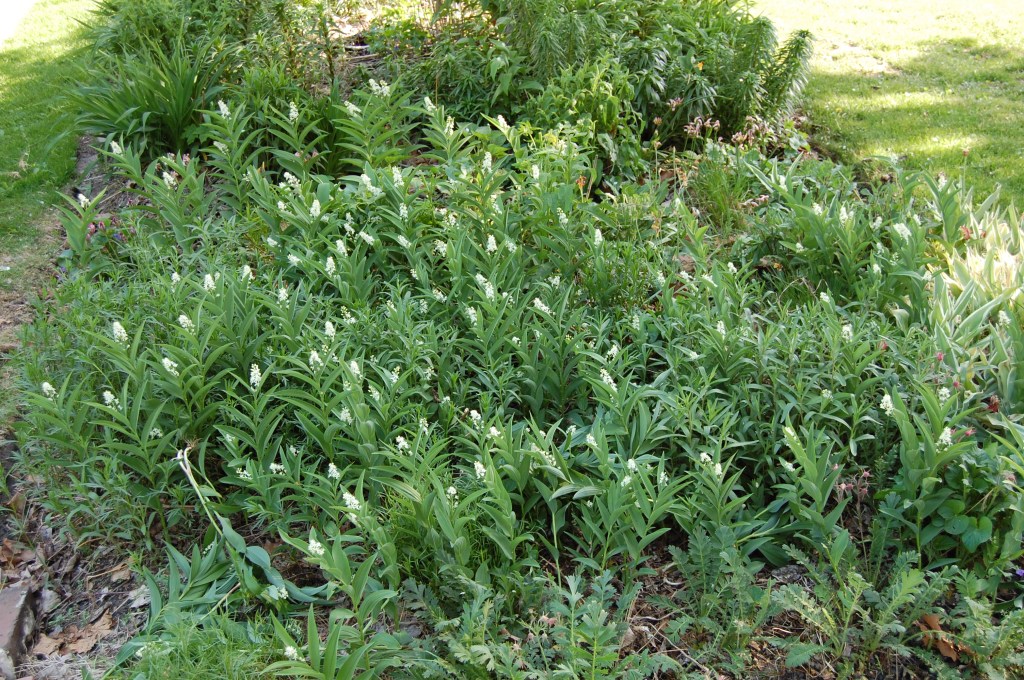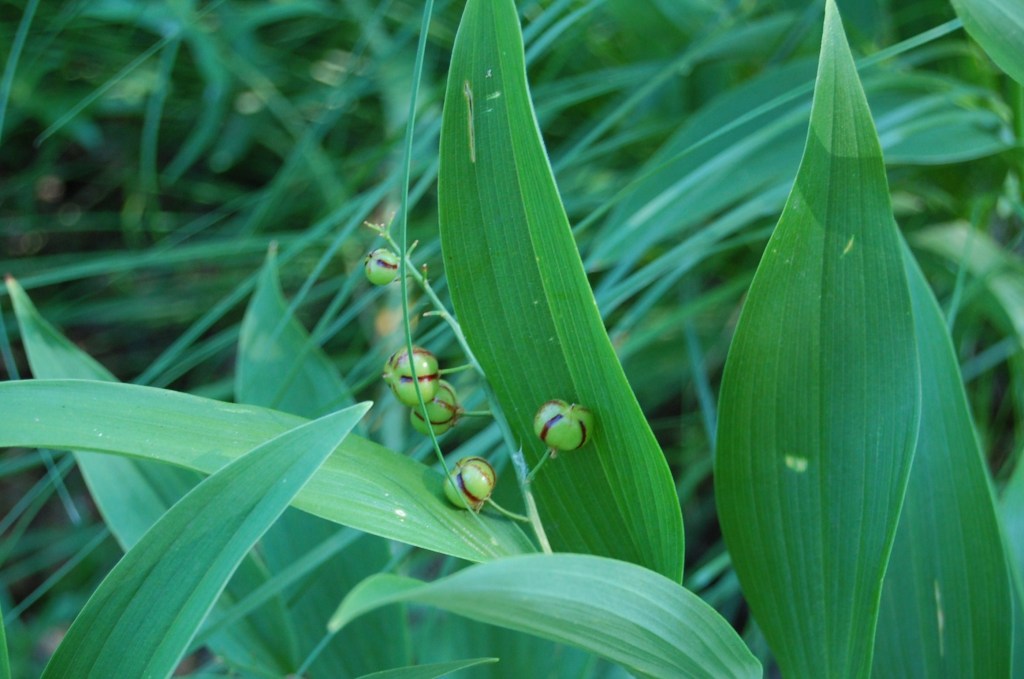Wildflower Wednesday: Starry Solomon’s Plume
Starry Solomon’s Plume is more properly known as Starry False Solomon’s Seal, but the people who write plant catalogues don’t like common names with “false”, it must drive down sales, so they came up with something with a more positive ring. I think they did right, because the other name implies that the plant is trying to pass itself off as Solomon’s Seal, and we really have no reason to suspect it of such duplicity.

The botanical name is Maianthemum stellatum, but until recently was Smilacina stellata (the taxonomists strike again – grrr.)
Like Solomon’s Seal, Starry Solomon’s Plume has a single stem lined with glossy, lance shaped leaves. In spring, there is a cluster of small, star-shaped white flowers at the end of the roughly one foot stems, followed by interesting striped berries in fall. For me the foliage and berries are the most attractive features. Right now is when the flowering is at its peak.

This is a tough plant that will tolerate dry shade. It spreads by rhizomes, but not so thickly that you could really consider it a groundcover. Taller plants can coexist with Starry Solomon’s Plume, but shorter plants like Prairie Smoke (Geum triflorum) will need the gardener’s protection.

Starry Solomon’s Plume is native to most of the USA and Canada. Grizzly bears and ruffed grouse are said to eat the berries, but I can’t verify this because there are no bears or grouse in my neighborhood, ruffed or otherwise. I like to think that an adventurous robin or two will give the berries a try, or maybe a bluejay, but I don’t know.
Wildflower Wednesday is hosted every month by Gail at Clay and Limestone.





A plant with pretty little white flowers, lovely foliage and a ‘wise’ name to match. How wonderful!
Very pretty!
Happy Gardening!
Lea
Lea’s Menagerie
I see these quite often while hiking; they seem to grow province-wide. In Linda Kershaw’s book Alberta Wayside Flowers, she says that historically, the rootstocks were used like onions to flavour food, but they were so bitter that they had to be soaked in lye and then rinsed and boiled to remove the strong flavour (and the lye residue). Doesn’t sound in the least bit appealing.
Sounds like I should leave the rootstocks in the ground. They do look a bit like Chinese radishes, though.
The plants pictured have a much more upright growth than those I see in the woods. Our native plants have a more arching habit like true Solomon’s seal.
These stay pretty short. Could yours be the non-starry Solomon’s plume (Maianthemum racemosa). It is taller and more arching, also has red berries instead of striped.
I am unfamiliar with this plant…nice foliage with a interesting flower much like a short tiarella….and it is a native to my area so I will add it to my list…thanks!
You’re welcome. I never thought of it but the flower is like a short Tiarella.
A beautiful plant.
These taxonomists don’t have any other jobs? I agree that the berries look really unique. Can we eat them?
It’s not really considered edible for humans. And I am convinced that changing plant names is how taxonomists keep themselves employed.
Jason, I know this plant. We call it “Kupena” and it’s said that Solomon’s seal – a plant of the lily family, vaguely reminiscent of lily of the valley. It’s hardy and don’t suffer of frost.
Interesting that there is a similar plant in Russia. The two must come from a common ancestor.
I’ve never heard of this plant, but it’s pretty. I like the little berries. But I wish they would quite changing plants’ latin names!
The berries are very nice.
Love to learn about new (to me) plants, so thanks for such a nice and informative profile.
Very glad you liked it.
I didn’t know they changed the common name…It’s a pretty thing no matter what it’s called. I have several plants in my garden and need to make sure that I can see them better they’re hidden under the hypericum! Happy WW to you.
Yes, it’s easy for them to be overlooked when there are taller plants.
Oh, I am seeing them all over gardens in PA. They make a nice groundcover in the forested spots.
In PA but not upstate NY?
Not really.
Very pretty! I’ve got the variegated version. Love it!
I have not seen the variegated version, I imagine it is lovely.
Love a “tough” native plant, glad to learn all about this one, thanks!
You’re welcome!
I’m always after a tough plant that endures dry shade. I’ve tried the ‘true’ Solomons Seal but it wasn’t tough enough, so as far as i’m concerned, that one is the ‘false’ one and this one is the true one! Which just goes to show that truth is subjective. Shame there’s no grouse in your neighbourhood – I’ve heard they make for good eating. Just as well there’s no bears though … cheers, cm
Well, it grows in Texas, Arizona, and Mexico, so maybe it would do well in Australia.
I like the striped berries and the fact that it likes dry shade. I have lots of dry shade! You say it “spreads by rhizomesbut not so thickly that you could really consider it a groundcover.” How aggressively does it wander? Do you have to keep it in check frequently?
Moderately aggressive. I pull out stems a couple of times per year.
Very nice. I just saw some of these yesterday at the nature center. Your patch is very impressive! I have the other Solomon Seal in my garden. Both are wonderful plants!
I planted some Solomon Seal in the east bed. This is its second spring, it is starting to get established.
I will have to make a note of these!!! I am always looking for new things to add to my shade garden that have nice height! They are beautiful! Thanks Jason!
I’m always happy when a plant does not need staking!